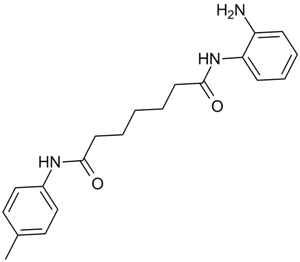TC-H 106 (Synonyms: RGFA-8; TC-H 106; Histone Deacetylase Inhibitor VII) |
| Catalog No.GC13591 |
A tight-binding inhibitor of class I HDACs
Products are for research use only. Not for human use. We do not sell to patients.

Cas No.: 937039-45-7
Sample solution is provided at 25 µL, 10mM.
TC-H 106 is an inhibitor of Class I Histone Deacetylase with IC50 values of 150, 760, 370 and 5000 nM for HDAC1, HDAC2, HDAC3 and HDAC8, respectively [1].
Histone deacetylases (HADC) are a series of enzymes that remove acetyl groups from an ε-N-acetyl lysine amino acid on a histone and make the histones to wrap the DNA more tightly, which prevent transcription. Class I histone deacetylase are consist of HDAC1, 2, 3 and 8 [1].
In a lymphoblastoid cell line from a Friedreich ataxia patient, TC-H 106 (2 μM) prolonged acetylation of histone H3 [1]. In HeLa cell, TC-H 106 inhibited HDACs with IC50 value of 1.3 μM. TC-H 106 inhibited recombinant HDAC3/NcoR2 and recombinant HDAC1 with IC50 values of 0.79 and 0.24 μM, respectively [2].
In KIKI mice carrying a (GAA) 230 repeats in the first intron of the mouse frataxin gene, TC-H 106 increased the level of frataxin mRNA. The histone H3 and H4 acetylation in chromatin near the GAA repeat was also increased. These results resulted in the frataxin return to the normal level in the nervous system and heart in KIKI mice [3].
References:
[1]. Chou CJ, Herman D, Gottesfeld JM. Pimelic diphenylamide 106 is a slow, tight-binding inhibitor of class I histone deacetylases. J Biol Chem, 2008, 283(51): 35402-35409.
[2]. Xu C, Soragni E, Chou CJ, et al. Chemical probes identify a role for histone deacetylase 3 in Friedreich's ataxia gene silencing. Chem Biol, 2009, 16(9): 980-989.
[3]. Rai M, Soragni E, Jenssen K, et al. HDAC inhibitors correct frataxin deficiency in a Friedreich ataxia mouse model. PLoS One, 2008, 3(4): e1958.
Average Rating: 5 (Based on Reviews and 30 reference(s) in Google Scholar.)
GLPBIO products are for RESEARCH USE ONLY. Please make sure your review or question is research based.
Required fields are marked with *




















